Fishing from a sailboat isn’t quite as simple as on boats purpose-built for fishing. Yet, it can be really rewarding and we found it’s amazingly fun in Alaska, where fish are plentiful. In 2 of our 6 seasons cruising WA and BC we fished occasionally but never caught anything. It took coming to Alaska to finally learn how to fish.
From April thru August 2021, we caught 47 fish over the course of about 50 days with active fishing effort. Some days we’d spend a couple hours out in the dinghy, catching nothing. Other days we’d go out and catch something within 15 minutes.
-
- 13 Halibut (all 18-25” except for one 51” monster!)
- 21 Salmon (13 silvers, 7 pink, and 1 sockeye)
- 6 Pacific cod
- 7 Rock fish
- 28 Dungeness crab (we stopped crabbing around July when we switched to focusing on fish)

Fishing requires knowledge, patience and skill. It can be very frustrating at times (like when sitting in the cold rain not catching anything, or when we lost gear to the bottom). Yet it can be rewarding – other than being vegetarian, I think catching your own protein is one of the most sustainable ways to live in a remote area.
Catching our own food gave us a much deeper appreciation for the sacrifice made, motivating us to respect every fish caught – safely releasing ones we didn’t keep and carefully filleting the ones we did keep to maximize use. Meat (and groceries in general) is quite expensive in Alaska, especially in the small remote villages we visit when cruising by boat. Many of the small towns get their groceries by barge just once a week, and most of their meat is frozen – we found frozen beef with “packed on” dates from over a year ago!
Buying groceries in the store means lots of fuel was burned to ship it there (container ship, barge and truck) and refrigerate it. When catching fish we could be sure that it was as fresh as it could possibly be and processed in the most optimal way. Fish is also extremely healthy, packed with healthy omega-3 fatty acids.

The first salmon I ever filleted (a sockeye). An imperfect filleting job, but I got better after this.

We had a lot of fish tacos and also numerous other delicious preparations.
Fishing Advice
A few caveats – we’re not experts and there are certainly people that know a lot more! (like all the sport charter fishing guides and commercial fisher-people). Fishing isn’t a science and sometimes stuff that should work doesn’t (or vice versa). Fishing is very seasonal and I’m not going to cover that or other things you can easily learn from existing online resources.
Also worth noting – in the fishing world many people are protective about their fishing spots and can be secretive or even hostile towards newbies. This is quite a contrast to the sailing / boating world where there’s a culture of helpfulness, especially towards newcomers. Certainly not everyone takes this position (we met very helpful people too!) but some people who fish believe that additional people fishing will “steal” their fish or deplete the prime spots.
I don’t buy this argument because beginners who are truly interested in learning fishing will learn to do it whether you help them or oppose them. So it seems much better to me to be helpful and sharing of information. In the modern era of Internet and social media, there are no truly “secret” spots anymore anyway.
And for those who think an additional sport fisherman is going to deplete the availability of fish for themselves, they should consider that industrial-scale commercial fishing operations are harvesting far more fish than a sport fisherman, well before it gets to their preferred spots, with a lot of bycatch (unintentionally caught fish which are often wasted).

The Dungeness crabs can be very big in Alaska – often 8-9″. (Note: I have a proper crab ruler but it doesn’t go this high – that’s why I pulled out the tape measure).
Sailboat Fishing vs Traditional Sport Fishing
Fishing while cruising on a sailboat has a few unique aspects to it.
Cons:
- Sailboats have limited space for fishing rods and filleting tables.
- High freeboard means it can be hard to reach down to the water to net a fish.
- Sailboats go slow and usually don’t have trolling motors (you can use the diesel for this but it’s not ideal).
- Storage / freezing – a sport fishing boat usually returns to a land home where they have a large freezer to store the catch in. Cruising sailboats have to eat all their catch relatively quickly or have a way to preserve it.
Pros:
- Cruising boats have more range for getting to the best fishing spots. Areas close to major cities (Juneau, Wrangell, etc) get heavily fished by the locals in trailerable boats – very few of those boats can go 2 weeks from port.
- You can fish while sailing, using no fuel at all!
- Flexible modes for different ways of fishing

The 4′ 3″ (~64 lbs) halibut I caught from the dinghy (quite a challenge – had to do a beach landing) and filleted at anchor on the foredeck.
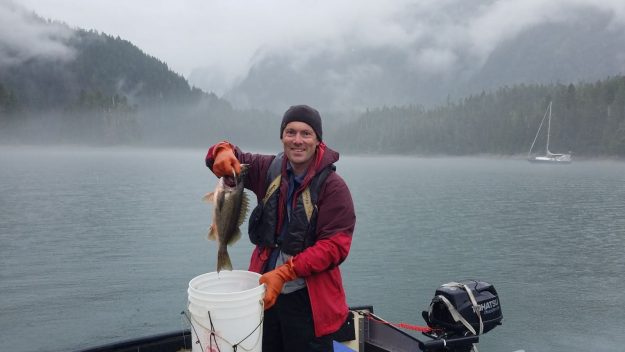
Fishing from the dinghy. This was my preferred mode about 80% of the time. Photo credit: SV Tulli
Modes:
- 1) Fish from the sailboat while underway
- a) while sailing
- b) while drifting – no sails up or heaved to; wind or current will increase rate of drift.
- c) while motoring (engine on, trolling)
- 2) Fish from the dinghy (sailboat at anchor)
- 3) Fish from the sailboat at anchor
One of the biggest challenges was figuring out which mode we prefer, and how to make it easier. In past years in BC we haven’t fished very much (and never successfully) partly because we don’t like fishing while underway. Since there’s limited time (and energy) in the day, it competes with sailing time. Sailing is our #1 priority, and often with light wind it takes up a very large amount of time.
Fishing on a Sailboat Underway:
Fishing while underway often means running the diesel at idle for quite a while – not only is this not great for a diesel engine, our engine is very loud and takes away the peacefulness of being out on the water. Alternatively, we can fish underway while sailing, but this is pretty difficult in the PNW. Tack/jibe lines take us across straits, and the middle of a strait isn’t the best place to find salmon. Plus you can’t be moving faster than 3 kts or so or you’ll probably be too fast for trolling – if more wind shows up, it can mess up your fishing.
To fish for bottomfish you need to be not moving (much). So one technique we’ve used while enroute to our next anchorage is drift fishing. Ideally, with little wind and no current you may not move at all, so the trick is to just stop in a good fishing spot and turn off the engine. However, positioning the boat in current, near rocky shorelines and headlands can be tricky and requires vigilant situational awareness.
Fishing from the Dinghy:
This is the method I grew to prefer. Once anchored, I could pretty quickly put the outboard on our Portabote and zoom out of the anchorage planing at 10 kts with our 6hp 4-stroke outboard. While we could go perhaps 6 nm this way, a range of 2 nm was preferable because going fast in the Portabote isn’t very comfortable. I wouldn’t go far out into major straits where dangerous waves can build quickly, and if the wind comes up it can be a cold, wet ride.
But the advantage is a dinghy can be moved easily and quickly to try new fishing spots, it can easily troll at 2-3 kts for salmon fishing, landing a fish is easier because you’re closer to the water line, and it confines the mess (scales and blood) to your dinghy instead of the entire boat deck or cockpit.
One downside is a dinghy is less comfortable – our seats with no back support are pretty killer after an hour, and we don’t have all the at-home comforts of the sailboat (heating, wind/rain protection, a galley, etc).
Fishing at Anchor
This was our least used mode, since it’s less common for an anchorage to have lots of fish in it (fish congregate out in the straits, near points or bottom features that bring them food sources on the current). But, halibut sometimes do head into anchorages and we caught one at anchor that way (the great thing about fishing at anchor is you can leave the bait in for hours, just checking it occasionally). You can also cast artificial lures or jig at anchor, which we saw some boats doing but we haven’t yet caught anything that way.

In some anchorages, salmon were literally jumping around our boat while at anchor.
Fishing Gear
Fishing gear is overwhelmingly confusing because there are thousands of variants, and many of them aren’t labeled or documented well. To make matters worse, the costs can add up quickly (since there are so many little things to buy) and the big ticket items (rod, reel) can range from budget priced to sky high.
All of our items are on the budget side of things. Our initial approach, from past experience not catching any fish in BC, was that we wanted to justify our gear expenditure by catching enough fish to equal the gear value, compared to buying the fish in the grocery store ($12-22/lb for salmon or halibut).
Also my opinion is that very expensive gear doesn’t catch fish that much quicker. It may provide some minor edge and conveniences, but we found pretty basic gear was sufficient in Southeast Alaska. I think being in the right place at the right time, and being skilled at the right fishing techniques, is usually more important than having the latest and greatest technology.
Must Haves:
- License, regulations pamphlet, Harvest Record card, and fish identification guides (rockfish, salmon, bottomfish).
- Southeast Fishing Atlas: Salmon Holes and Halibut Hills (free PDF)
- 6’ rod – Penn Mariner II Boat rod – I used this because around 6’ is recommended for halibut. This worked fine for salmon, rockfish and cod too.
- Penn Level Wind reel
- or Okuma Cold Water 303d line counter reel – we’ve now upgraded to these (more expensive, but well worth it if you’re doing a lot of fishing)
- 200 yd (600’) of 80lb braided line (ex: KastKing)
- around 60-80lb test is good in case you get a big halibut, braided line is better than monofilament because it’s thinner and will have less drag in current, and you want about 450’ in length because halibut fishing can be as deep as 200-300’.
- 80lb line is overkill for salmon and other fish (only need 20-30lb) but we found this worked fine for them all. Having one rod/reel saved money and space.
- Fishing line leader, 20-30 lb – for connecting things, lures, salmon flashers, divers, etc.
- Multitool for cutting line, prepping hooks, removing hook, etc.
- Fillet knife – we typically have a bait knife for fish cleaning, bleeding and bait prep and a fillet knife (like Rapala 6″ or 7.5″) for the actual filleting.
- Descender – mandatory in Alaska (see regulations) for descending non-retention rockfish. (Or a Fancy version)
- Connecting hardware such as swivels.
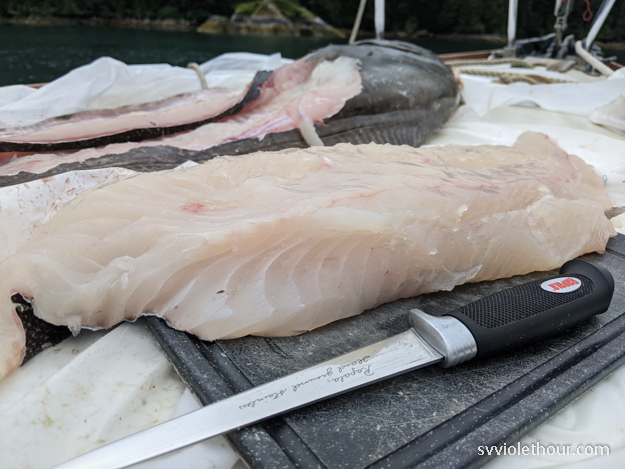
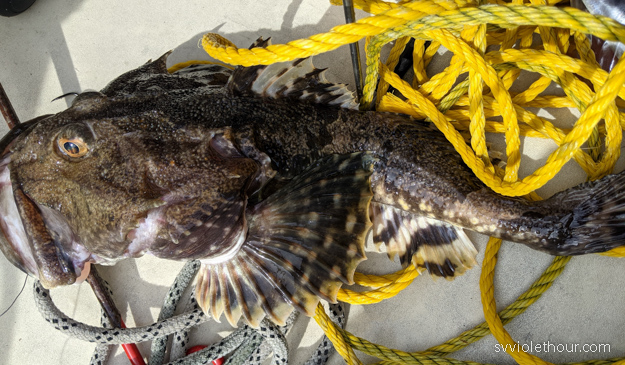
Fish identification can be tough. Our first fish caught was a large cabezon / sculpin / “bullhead”. We usually release these because they’re usually small, but some people like to keep them (good in stews or fried+breaded – the meat is a bit more chewy / dense than other fish).
Halibut fishing / Bottomfishing:
- Spreader bar with 8-16oz cannonball weight.
Helps prevent the lure / bait from getting tangled with the main line. You can bottomfish without a spreader bar, but I found it helpful when in deep water with current (most halibut fishing in AK). To avoid tangles you need to make your hook leader slightly shorter than the long arm of the spreader bar.

- Double circle hook leader for fishing with herring. (This same setup often works for Pacific Cod too). I used mainly size 8/0 or 9/0 hooks.
- Artificial jigs – useful if you run out of herring, or if there are other fish species stealing your herring bait (sculpin + rockfish are good at this):
- P-Line jigs in heavier weights (11 or 14oz).
Next year I want to try this Ahi Diamond Jig. - Leadhead jig with a rubber lure like the Berkley Gulp line.
- Buzzbombs – good for jigging for smaller fish like rockfish. I haven’t caught a halibut with one.
- P-Line jigs in heavier weights (11 or 14oz).
- Gaff hook or spear/harpoon
- Club (or use the handle end of the gaff hook – carefully).

Herring on a double circle hook setup. I made some improvements to the hookup later (losing herring is a nuisance inherent to fishing with bait) and many people have their own favorite technique.
Salmon Fishing:
- Deep Six Planing Diver – helps get the lure deeper while trolling. Sport fishing boats use downriggers, but those are expensive and take up room on deck for mounting (although some sailboats do mount them). Note there are different sizes to this – I like to have a big one (5″ / 5oz) for deeper salmon trolling from the dinghy and a smaller one (3.5″) for trolling while sailing.
- Net – salmon are acrobatic fighters (especially Coho/silvers) and a net helps get them onboard before they can spit the hook. For bottomfishing I found a net to be unnecessary but it may help in some cases. Nets, unfortunately, are expensive! Get a good one and don’t lose it.
- Flasher
- Artificial lures:
- Spoons like the Silver Horde line
- Hoochies (plastic squid lures) with a one or two hook leader (3/0 or 4/0 hooks)
- Buzzbombs
- Casting lure like the Blue Fox Pixee Spoon
- Note: you can fish for salmon with bait (herring) too but we never had much luck with that. Might be more critical for king salmon. We found silvers and pinks will bite anything, as long as it has a color and motion to attract them.

A beautiful sockeye caught trolling a Buzzbomb on a diver (without a flasher) in late July. Pure luck (sockeye are hard to catch in open water – this one was in Chatham Strait off Waterfall cove) – the only sockeye we caught.
Optional:
- Tackle box – we used a Tuperware container for a while but a tacklebox is nice.
- Alaska Fishing (3rd ed) by René Limeres and Gunmar Pedersen. I found this book in the Juneau library after our summer of fishing (and wish I had known about it beforehand because it would’ve answered a lot of questions!). This is like the bible of Alaska fishing, so I highly recommend it if you can find it (not always in print but you could buy used or find it in a library in Alaska).
- Fishing rod holders
- Herring jig – we used these on a couple occasions to catch herring for bait. If you can find a herring ball it’s a lot of fun (watch out for humpbacks though)!
- Fish Filleting/Cleaning Board – a lot of other boats had these mounted. We relied on just an old plastic cutting board placed in the cockpit. This makes a mess and more cleanup work.
- A portable seat (with back) for our dinghy would make dinghy fishing a lot more comfortable.
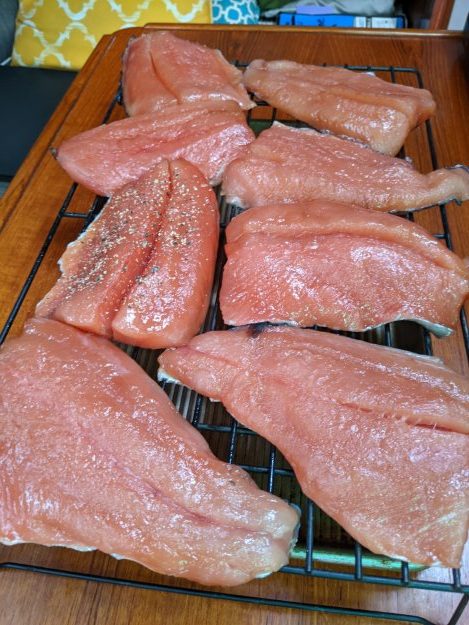
Smoking pink salmon. Later on when we started catching a lot of silvers (coho) we smoked some of that too.
Clothing:
It should go without saying, but Southeast Alaska is rainy and chilly, even for much of the summer. Having the right clothing is important for being comfortable and being able to stay out as long as you want to. Shorts + t-shirts fishing was rare.
- Waterproof outer layer: Helly Hansen Impertech Deluxe Rain Jacket
For sailing I often use a DWR coated (Goretex) jacket (Marmot 3-in-1 jacket). Different brands have various trade names but they’re all essentially fabric with a water repellant coating on top, and with all of them that coating wears away or degrades with time. You can re-treat the coating, but even then I’ve found it doesn’t stay dry with 1-2 hours in the rain.
Fishing in Alaska I found myself sitting outside in the rain for longer than I would be in the rain while sailing (because we have rain protection in our cockpit).
This Helly Hansen jacket is more like a plastic rain slicker (it uses a polyurethane coating). An impermeable layer is much quicker to dry out when you get back to the boat. And I haven’t found breathability to be a problem. - Would-be-nice: Waterproof phone case and mount for the dinghy. I use my phone for navigation (Navionics) in the dinghy, but fishing means I use it even more – checking our drift rate and position over depth contours and bottom features. A RAM mount would’ve been handy (since your hands are already occupied with a pole and tackle) and a waterproof case (my phone survived being rained on a lot, but I was pretty diligent about drying it off afterwards).
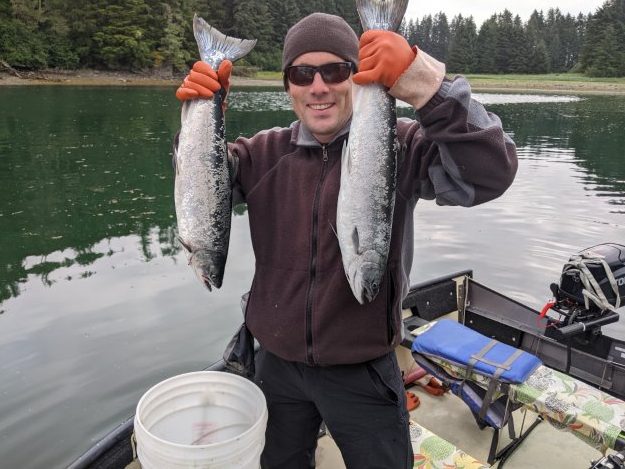
[This post contains Amazon affiliate links which help fund this site – the prices to you are the same and if you make a purchase within 24 hours of clicking a product we recommended, we’ll get a small referral bonus].





I am enjoying looking at your postings. Newby sailor. Thanks, Kevin
I like what you said about using a rain slicker. I need to get a new fishing pole. I’ll have to consider getting new bait as well.
Great article Patrick!
Excellent details with good references to external resources.
This is the fishing primer those planning to visit the NNE Pacific need to read.
Cheers! Bill
Thank you for the detailed article. Well written and thorough, like the rest of your website.
Cheers,
Lisa on SV Raven